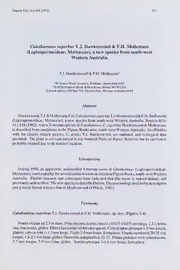
Calothamnus superbus T.J. Hawkeswood & F.H. Mollemans (Leptospermoideae : Myrtaceae), a new species from south-west Western Australia PDF
Preview Calothamnus superbus T.J. Hawkeswood & F.H. Mollemans (Leptospermoideae : Myrtaceae), a new species from south-west Western Australia
Nuytsia8(3):311-318(1992) 311 Calothamnus superbus T.J. Hawkeswood & F.H. Mollemans (Leptospermoideae: Myrtaceae), a new species from south-west Western Australia TJ. Hawkeswood'&F.H. Mollemans^ '49VennerRoad,Annerley,Brisbane,Queensland4103 ^76-6228PlumeriaRoad,Kailua-Kona,Hawaii96740USA [Currentaddress:POBox734,VictoriaPark,WesternAustralia6100] Abstract Hawkeswood,T.J.&Mollcmans,F,H,Ca/o//!t7WrtHd'5M;jcrftM^T.J.Hawkeswood&F,H.Mollemans (Leptospermoideae: Myrtaceae), a new species from south-westWestern Australia. Nuytsia 8(3): 311-318(1992).Anew5-merousspeciesofCalothamnus,C.superbusHawkeswood&Mollemans, isdescribedfrom sandplains inthePigeonRocksarea,south-westWestern Australia. Itsaffinities with the closely related species, C. aridus T.J. Hawkeswood, are outlined, and ecological data provided. Theplantis notrepresentedin anyNationalParksorNatureRe.servesbut itssurvival is probably ensureddue to its isolatedlocation. Introduction During 1990, an apparently undescribcd 5-merous taxon ofCalothamnus (Leptospermoideae: Myrtaceae),waslocatedbythesecondauthorinaremoteareanearPigeonRocks,south-westWestern Australia. Further research and collections have indicated that this taxon is indeed distinct and previouslyundescribed. Thenewspeciesisdescribedbelow.Theterminologyusedinthedescription andgeneral formatfollows thatofHawkeswood (1984a,b, 1987). Taxonomy CalothamnussuperbusT.J. Hawkeswood& F.H. Mollemans, sp. nov. (Figures 1-4) Frutexerectusad2.5maltus. Folialinearia,terctia,erecta,(10)13-15(18)cmlonga, L2-L6mm lata,mucronata,glabra. Floresfasciculativelbreviterspicati.Calycistubuspleraque4-5mmlongis, glabris;calycis-lobi 1-1.5mmlongi. Petala3-5mmlonga,ferruginea. Unguisstaminalis20-25mm mm longus,1.8-2.1 latus,glaber;filamentismarginalibus12-17. Frutusglobulusvel±cylindraceus, 5-7 mm longus,7-9 mm latus, glaber. Seminapleraque 1-1.4 mm longa, ferruginea. 312 NuytsiaVol.8,No.3(1992) Figure 1. T.J,Hawkeswood&F.H.Molleman.s- Holotype (F.M.&M.P.Mollemans3078). T.J.Hawkeswood&F.H.Mollemans, Calothamnussuperbus 313 Figure2. HabitofCalothamnussupcrbusT.J.Hawkeswood&F.H.Mollemans inmixedshrublandandheathnearPigeonRocks. (Photo:F.H.Mollemans). Typus: TrackfromEmuFence,easttowardsPigeonRocksTank&westofClamptonMineralProspect (prcciselocalitywithheld),alt.c.510m;abund;uiceuncommon;11 July1990,F./f. &.M.P. Mollemans 3078 (holo: PERTH). (Figure 1) Erect, wide, compact to spreading, multi-stemmed, diffuse branching, straggly to somewhat compact,glabrousshrubsto2.5metreshigh, with thickstemsandhardgreybark,oftensplittingat ornearthebasesofthetrunks. Youngbranchesmostlyglabrous. Leavessessile,linear,terete,erect, rsitgriadi,gh(t10a)p1e3x-145-(718m)mcmlloonngg,,b1r.i2g-h1t.6pmalme gwriedeen,gtloabyreolulso,wirsohu-gghr,epeunn;geonilt,gnlaanrdrsowveedryinptoroamtihinne,nsthaarnpd, exsertedinto theepidermis, giving risetotherough leafsurface. Flowers2-5 (mostly 3) arranged in a cluster or 5-8(10) in a loose spikeamongst leaveson youngerbranches. Calyx-tube narrow campanulate to almost cylindrical, 4-5 mm long, glabrous; oil glands prominent; rhachis usually mm dilated at thebase ofthe calyx-tube; calyx-lobes deltoid, mostly acute, concave, 1-1.5 long, mm glabrous;marginsthin,scarious,partiallyciliate. Pcm/j'obovatc,concave,obtuse,3-5 long,thin, mostly glabrous, but with a few simple, scattered hairs, orange-brown; margins thin, glabrous. Staminal claws±equal,free,20-25 mm long, 1.8-2.1 mm wide,glabrous,orange-redin lowerhalf mm totwo-thirds,pink-redin upperportion; marginalfilaments 12-17; anthers linear, 1-1.4 long, brown. Styleslender15-25mmlong,glabrous,pink-red,stigmasmall,oftenpersistentinyoungfruit. Summit ofovary densely pubescent. Fruit globular or depressed globular to almost cylindrical (rarely),5-7 mm long,7-9 mm wide, smoothorwith irregularbulges,ribsand/orstriations,mostly truncateorveryshortly5-lobed(calyx-lobespersistentinyoungfruitandusuallyab.senlinolder,worn mm fruit). FertileiecfJslinear-oblong, 1.0-1.4(1.5) long,angular,cuneate,oftenobliquelytruncate, mm glabrous;testadarkreddish-brown. Ovulodessimilartofertileseeds,mostly1.0-1.2 long,slightly palerin colour, usually obliquely truncate, glabrous. 314 NuytsiaVol.8,No.3(1992) Figure 3. Close-up of a branch of Calolhamrms superbus T.J. Hawkeswood &F.H.MollemansinmixedshrublandandheathnearPigeonRocksshowingaclusterof youngfruitingcapsules. (Photo:F.H.Mollemans). Other-specimens examined. WESTERN AUSTRALIA: Pigeon Rocks (Clamptons Vermin Fence track,eastofverminfence),12July \99\,F.H.Mollemans3S12(PERTH);PigeonRocks(Clamptons Vermin Fencetrack,eastofvermin fence), 13 July 1991,F.H. Mollemans3813 (PERTH). Distribution. KnownonlyfromtwositesinthePigeonRocksarea(29‘^52'S, 118°39’E),south-west Western Australia (Figure 4). C. superhus occurs c. 100 km south ofthe most southerly known occurrence of C. aridus, and the northernmost distribution of C. gilesii is sympatric with that of C. superhus. ThesympatricdistributionofC.superbusandC. o/Zej/icausedinitialconfusionduring the return collection trip in July 1991 (because of morphological resemblance), however, it was determinedduringa3 km transecton footalongClamptonsVerminFence track that C. gilesiiand C. superhusare not sympatricat the local scaleas they do notgrow together. Habitat. Growsin paleyellow brown sand with scatteredferruginouspebbles oflateritein mixed sandplainheathwilhAcacia(Mimosaceae),Grevillea(Proteaceae)and/4//ocfliMa/'i/ifl(Casuarinaceae) orinpaleyellowbrown sandinmixedshrublandandheathwith Grevillea(Proteaceae),Melaleuca (Myrtaceae) andBoronia ternala (Rutaceae). Floweringandfruitingperiod.FloweringinJuly1990whentheinitialcollectionwasmade,butplants were in fruit in July 1991; this taxon is therefore thought to flower opportunisticly depending on rainfall. Conservationstatus. 2V using thecriteriaofBriggs&Leigh(1988). Calothamnussuperbusisnot represented in any National Park or Nature Reserves but its isolated location should afford a significant degree of protection from land clearing, residential development and illicit flower collection at least in the near future. However, at one ofthe sites where C. superbus was found {Mollemans 3812), there wasevidenceofarecentfiresothatbushfiresmayprovetobeapossible T.J.Hawkeswood&F.H.Mollemans, Calothamnussuperbus 315 Figure4. DistributionofC.superbusT.J.Hawkeswood&F.H.Mollenians. andseriousthreatespeciallyconsideringthesmallsizeofknown C. superbuspopulations,viz.only about25plantswerecountedbyMollemansatthefirstsite(Mo/Zmanx3812)andaboutISattheother site{Mollemans3813). ThedegreeofsusceptihilityofC.superbustofiresisnotknownandperhaps firesandtheireffects shouldbeclosely monitoredin the future. Etymology.Thespecificepithetsuperbus,fromLatin,meaning impressiveorexalted,refersinpart tothedistinctivepalegreentoyellow-green,erectfoliageofthisspeciesandtotheplantsprominence in thelocalized area within which itoccurs. Discussion Thereareabouttwenty5-merousspeciesofCalothamnus,andC.superbusismostcloselyrelated to C. aridus T.J. Hawkeswood (Hawkeswood 1984a). A comparison of some taxonomic and ecological featuresofthesetwo speciesisprovided in Table 1. Morphologicaldijferences. C. superbusandC. ariduscanbeclearlydistinguishedon thebasis of thefourleafcharactersgiveninTable 1. Differencesinthemorphologyandsizeofthecalyx-tube, petal pubescence, width ofthe staminal claws andthe numberoffilamentsper staminal clawalso distinguishC.superbusfromC.aridus. Ofthesecharacters,leafsize(lengthandwidth),pubescence ofcalyx-tubeandthenumberofmarginalfilamentsperstaminalclawarethemostimportant. Fertile seed sizedifferencesarealso highlysignificant (Table 1). 316 NuytsiaVol.8,No.3(1992) Table 1. ComparisonofsomeimportanttaxonomicandecologicalfeaturesofCalothamnusaridus T.J.Hawkeswoodand C. superbusTJ. Hawkeswood&F.H. Mollemans Character C.aridus C.superbus Leaflength (mm) (5)7-10(12) (10)13-15(18) Leafwidth (mm) 0.6-L2 1.2-1.6 Leafcolour Darkgreen to Brightpalegreen olive green toyellow-green Leafapex length (mm) 2-3 4-7 Calyx-tube length (mm) (2)2.5 4-5 Calyx-tube Pubescent Glabrous Petals Densely pubescent Fewscatteredhairs Petalmargins Ciliate Glabrous Staminalclaw width(mm) 1.0-1.5 L8-2.1 Numberofmarginal 10-12 12-17 filamentsperstaminal claw Fertileseedlength (mm) L5-2.0 L0-L4(1.5) Habitat Redsand,Triodia- Yellow sand,mixed Eucalyptus woodland; heath,sandplain Triodia sandplain FruitsizehasbeenimportantindelineatinganddifferentiatingotherCalothamnustaxa(Hawkeswood 1984a,b, 1987),butthischaracter is not so readily applicableindistinguishing C.rapcrfmrand C.aridus. ThetwoknownpopulationsofC.superbushavevariablefruitsizewithmanyfruitslarger thanthoseofC.aridus,butthereisanoverlapinsizerangeoffruitsofthetwospecies,sothischaracter, ifusedin isolation, isnotreliable in differentiating the twotaxa. Non-flowering C. superbusplantsresemblethoseofC.gilesii¥. Muellbutthefruitofthelatter speciesarenotdepressed-globularinshape. Inaddition,thefruitsofC.gilesiiaremuchlargerthan thoseofC.superbus,andC.gilesiiisnotsotallorbroadinhabit,nordoesithavethesuperbascending leavesofC. superbus. Ecologicaldijferences. CalothamnussuperbusandC.aridushavethemostinlanddistributionofany speciesinthegenus. However,thehabitatsin whichtheyoccurarequitedifferent(Table1)andthe soil type and other environmental factors may have been important in the evolution and genetic integrityofthesetwo species. T.J.Hawkeswood&F.H.Mollemaiis, Calothamnussuperbus 317 Possible evolutionary relationships. C. superbus, like all species of Calothamnus, other than C. aridus,lackspubescentpetals. ThisisanimportantdifferencebetweenC.superbusandC.aridus, andmaintainsC.aridusastheonlyspeciesofCalothamnuswhichpossessespetalscoveredinshort, appressed,simplehairs (seeHawkeswood1984a). Despilethisdifferencc.itisveryclear,onthebasis ofothercharacters (seeTable T) that C. superbusis verycloselyrelated to C. aridus. Hawkeswood (1984a), noted that C. aridus was not closely related to any other Calothamnus species. Butthenew speciesC. superbus,becauseofitslackofpetalpubescenceanditsveryclose relationshiptoC.aridus,appearstoprovidealinkbetweenC.aridusandotherCalothamnusspecies whichhasnotpreviouslybeenevident. However,absenceofpetalindumentumisonlyonecommon characteramonganumberofcharactersinwhichC.superbus(incommonwithC.aridus)differsfrom other species of Calothamnus, so the apparent link between C. aridus and other species of Calothamnusprovidedby C. superbusis in factonlysuperficial. C.aridushasanaridzonedistribution. Thepresenceofpetalindumentuminthisspeciesandits absenceIVomotherCalothamnusspecies,includingC.superbus,whichoccurnearertoorwithinthe floristically diverse transitional rainfall zone of Western Australia where marked spcciation has occurred(seeHopper 1979),suggeststwothings. Firstly,thatpetal indumentum isnotrequiredby Calothamnusspeciesgrowinginmarginaltohigherrainfallareas,butmayhavesignificantadaptive valueinthearidzone. PetalpubescenceinC.aridusprobablydevelopedasaresponsetodeveloping aridity since theseparation ofAustraliaand Antarctica. Secondly, based on ourknowledgeofthe floristicanatomy anddistribution ofCalothamnus, theevolutionaryrelationshipofC. superbusto C. aridusandtoothermembersofthegenusappearstobecomprisedofanumberoflineagesarising from a common ancestor, which reflect evolution in response to local and regional influences. Determinationoftheactualarrangementoflineagesin wouldrequireadetailedcladistic analysis(e.g.Westonetal. 1984),whichisbeyondthescopeofthispaper. However,inahypothetical cladogramitislikelythatC.superbusandC. ariduswouldformacommonclade,whichisgenerally removedfromallotherspeciesofCalothamnuspresentlyknown,apartperhapsforatenuouslinkwith C. gilesii. Acknowledgements WewouldliketothankJimArmstrong,NevilleMarchantandthestaffoftheWesternAustralian Herbarium(PERTH)forassistanceinworkassociatedwiththepreparationofthispaper. Thesecond authormadetheinitialcollection,thetype,ofCalothamnussuperbuswhileemployedoncontractwith theDepartmentofConservationandLandManagement(CALM)onasurveyofrareflorainCALM’s MerrcdinDistrict,aprojectfundedjointlybytheAustralianNationalParksandWildlifeServiceand CALM. F.Mollemanswishestoacknowledgethefundingbodiesandtothanktheprojectsupervisors DrD.J.CoatesandMrP.Brownfortheirsupportandencouragementduringthatproject.Constructive criticisms by an anonymousrefereepointedoutaspectsofthispaperrequiring improvement. 318 NuytsiaVol.8,No.3(1992) References Briggs,J.D.andLeigh,l.H.(1988)."RareorTlireatenedAustralianPlants."Revisededn.(AustralianNationalParksandWildlife Service,Canberra.) Hawkeswood,T.J.(1984a).NinenewspeciesofCatotliamruisLabi11.(Myrtaceae:Leptospennoideae)fromWesternAustralia. Nuytsia5:123-153. Hawkeswood,T.J.(1984b).CalothamnusaccedensT.J.Hawkeswood(Myrtaceae),arareandendangerednewspeciesfrom WesternAustralia.Nuytsia5:305-310. Hawkeswood,T.J.(1987).AtaxonomicrevisionofthegenusCalothamnusLabill.(Myrtaceae:Leptospermoideae).Part1.The 4-merousspecies.Nuytsia6:67-126. Hopper,S.D.(1979). Biogeographical aspects of speciation in thesouth-westAustralianflora. AnnualRev.Ecol.Syst. 10:399-422. Weston,P.H.,Carolin,R.C.andAnnstrong,J.A.(1984). AcladisticanalysisofBoroniaSm.andBoronellaBaill.(Rutaceae). Austral.J.Bot.32:187-203.
